An Ageless Chinese Doctor
August Derleth wrote a long
series of stories about a Sherlock Holmes stand-in named Solar Pons and his Watsonian
associate, Dr. Lyndon Parker. In "The Adventure of the Seven Sisters" (from The
Chronicles of Solar Pons, 1973), Pons tells Parker of a certain shadowy personage:
It is elementary that only a comparatively widespread
organization could produce, on demand, a lascar or dacoit to serve as a professional
assassin. There is only one such in London, to my knowledge. It is part of a world-wide
organization, headed, I am informed, by an ageless Chinese doctor of far more
than average intelligence----a legendary figure not only throughout the underworld
but also in the political world. Perhaps you have never heard of the Si-Fan?
In a story occurring later in the Pontine chronology, "The
Adventure of the Camberwell Beauty" (from The Return of Solar Pons, 1958),
there are further observations:
Let us refer to him simply as the Doctor. He is considered
by some persons a financial genius, by others as the most sinister man in the
complex underworld of London. [...] He has lascars, dacoits, thugs, and assorted servants
at his command.
Have you ever heard of the Si-Fan? And the Brotherhood of the Lotus? And the
much-touted Yellow Peril? [...] The Doctor is all of them.
The Doctor also figures prominently in "The Adventure of the
Praed Street Irregulars" (from The Reminiscences of Solar Pons, 1961).
Although the Doctor is never named, there is never any doubt of his identity. All
of Pons's encounters with him are appropriately Rohmerian in mood and detail. The
intriguing difference is that the Doctor and Pons are not overt antagonists. In two of the
stories mentioned above, the Doctor (for his own reasons, needless to say) provides
assistance in Pons's investigations, and in the other story it is the Doctor who actually
hires Pons to solve a case. All of the stories are well worth reading.
The Solar Pons stories were originally collected in several
hardcover volumes published by Derleth's own Mycroft & Moran imprint. They were
subsequently reprinted in paperback by Pinnacle Books, and in a two-volume slip-cased
omnibus edition by Arkham House.
Note: Win Eckert maintains an expanded and frequently updated Fu Manchu
Chronology which includes
the Solar Pons stories as well as some far more obscure references.
|
Opium
A character created by Spanish cartoonist
Daniel Torres.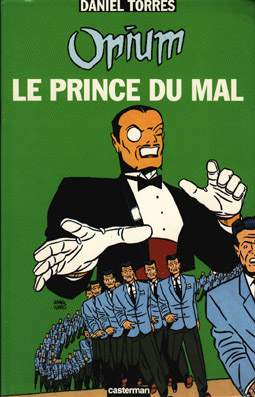
The character named "Opium" does have a number of traits in common with
the original Fu Manchu - he's an evil Chinese mastermind hell-bent on world
domination (but some of the stories seem to suggest he's doing it mostly for
kicks), whose plans include poisoning water supplies to spread panic,
brainwashing the kids with hypnotic pop records and controlling the masses
by printing hypnotic comic magazines (having kidnapped all the major
cartoonists to work them as slaves in his publishing company).
He's often described as "Yellow Peril" or "Prince of Evil". Opium's plans
are foiled (usually unwittingly) by his sworn enemy, a vain and silly TV
anchor, whose fiancé is usually abducted in each episode (in the end of the
first series, she apparently drops her macho boyfriend and strikes a
friendship with Opium's female sidekick). The series is designed with tongue
firmly in cheek, in a "clear line" style reminiscent of Tin-tin or The
Phantom.
It was published in Spain (by Norma Editorial), France (by Les Humanoids
Associes and by Castermann) and Italy (by Editoriale Del Grifo), that I know
of.
Submitted by Davide Mana,
Torino, Italy
|
Dr. Chu San Fu
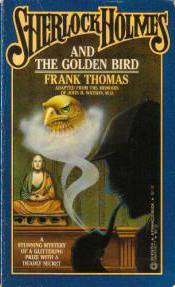 Frank Thomas. Frank Thomas.
Sherlock Holmes and the Golden Bird.
New York: Pinnacle,
October 1979. A Paperback Original.
Cover art by David Mann.
Sherlock Holmes and the Sacred Sword.
New York: Pinnacle,
September 1980. A Paperback Original.
Cover art by David Mann.
"I stood ten feet from a sizeable table that was elaborately carved . .
Behind it in a high-backed chair sat a Chinaman. His Oriental robe fit
tightly around his neck and tended to slenderize his body. His face was a
round yellow mask dominated by shrewd, slanting eyes. His head was domed and
festooned with a few wisps of hair and from his chin hung two strands of
white hair quite separated . . . While his white hair gave him a rather
benevolent look, he did not seeem of great age, though I would have been
hard-pressed to guess his years. The fingers were long and the nails were of
unusual length. One hand was gently stroking a small-headed animal with a
pointed muzzle, shot legs, and a long, nervous tail."
Sherlock Holmes and the Golden Bird,
page 193
-- Reported by Jeff Satterfield,
Bogart, Georgia, USA
|
 Weng-Chiang Weng-Chiang
Ithe 1976-77 season, Doctor Who of the long-running British science
fiction series battled a future version of Fu Manchu: Magnus Greel,
a war criminal from the 51st century who, after being thrown back to
the
19th, adopts the identity of an ancient Chinese god called
Weng-Chiang
--which helps him assert his authority among his Oriental devotees.
Alan Barnes, the co-editor of Marvel Comics' Doctor Who Magazine,
identified a number of definitive Rohmer elements in the Weng-Chiang scripts:
"You may also be interested to note various script elements which cement the
pastiche: that Greel's secret base, deep underneath the Palace Theatre, is first accessed
from beneath the Thames; that Greel prolongs his life by draining the 'life-essence' of
young women; that his various experiments result in a rat being mutated to giant size
(Greel uses it to guard the sewer access to his lair); and that, once his base beneath the
Palace Theatre is raided, Greel shifts his operations to a Limehouse laundry. Probably the
slyest nod towards Sax Rohmer in author Robert Holmes' script - which also contains many
elements from The Phantom of the Opera - is the Doctor (never 'Dr. Who'!) mentioning that,
having landed in the late 19th century, he's hoping to see Little Tich at the music
hall." |
The Talons Of Weng-Chiang, Part 1 (Originally Aired
2/26/1977)
The Talons Of Weng-Chiang, Part 2 (Originally Aired 3/5/1977)
The Talons Of Weng-Chiang, Part 3 (Originally Aired 3/12/1977)
The Talons Of Weng-Chiang, Part 4 (Originally Aired 3/19/1977)
The Talons Of Weng-Chiang, Part 5 (Originally Aired 3/26/1977)
The Talons Of Weng-Chiang, Part 6 (Originally Aired 4/2/1977)
The series was also released as a novel.
Terrance Dicks. Doctor Who - The Talons of Weng-Chiang.
Doctor Who library no. 61. Doctor Who Books: London, 1977. No. of pages: 140
pages. ISBN: 0 426 11973 8
The series was later edited and released as a movie.
The Talons of Weng-Chiang. Released: BBC Enterprises Ltd.
1988. Length: 136 mins. Rating: PG. BBCV no. 4187.
Another Weng-Chiang novel appeared in 1996.
David A. McIntee. The Shadow of Weng Chiang. Doctor Who
Books: London, August 1996. ISBN 0-426-20479-4
--The Weng-Chiang clone was first reported by Ralph Stewart.
|
Doctor Chou en Shu
Richard Jaccoma. Yellow Peril: The Adventures of Sir John Weymouth-Smythe.
New York: Richard Marek, 1978.
"I shall forever carry with me the vile memory of this, my first sight of the
Beast who would become my archenemy: a massive shaved head, a wide brow denoting a
phenomenal warped intelligence, unspeakably poercing eyes of an inhuman , yellowish green,
a titanic, ageless body, filled with evil strength! His name. its name I will give you
now, although it still twists my heart: the Master of the Dak Fang
. . . Doctor Chou en Shu!
Chapter
3 |
 |
Sax Rohmer is named as a significant member of The Golden Dawn
Lodge in chapter 13, but he is nowhere credited as the creator of the "yellow
peril" archetype so clearly the model of Chou en Shu and his Dak Fang. The hero's
name, Sir John Weymouth-Smythe, is a clear combination of the names of two Rohmer heroes:
Inspector Weymouth and Nayland Smith. Dacoits, well used Briars and a variety of poisonous
insects abound. Richard Jaccoma. The Werewolf's Revenge. New York: Fawcett,
August 1991.
Both Chou en Shu and Sir John Weymouth-Smythe return in Jaccoma's third book.
|
The Mandarin, Mr. King
Gahan Wilson. Everybody's Favorite Duck. The Mysterious Press: New York,
1988.
"An extremely tall, extremely thin man in an Astrakan hat and a long cape with a
high fur collar unfolded himself in a smooth, serpentine undulation, stepped out of the
car, and sniffed the fog with the loving appreciation of a true connoisser. His
descicated face was Oriental, schiveled as an Egyptian mummy's, and owned a queer calmness
which suggested a Buddha--but a suspect, devious Buddha, one altogether lacking in
compassion, a Buddha whose followers would undergo strange and occasionally fatal
enlightenments" (3).
"He had on his cap with the coral ball on top and his dragon robe and the whole
damn works, just like he was delled up for a meeting of the Council of Seven" (60).
"'This Chinese fellow, for example, who you say recently went by the name of, ah,
Mr. King . . .'
'Not only his most recent name, Mr. Greyer,' said Bone. 'I believe I said it has been
strongly hinted it may also have been one of his earliest, back in the London docklands
before the war, when he first became known to the Western authorities . . .'"
(78-79).
|
Fou Mancho

|
"Fou Mancho" (literally and phonetically, in French, "one-armed
crazy").
Sherlock Holmes and Watson versus Fu-Manchu? No, Cholms (a cat) and Stetson (a drunkard
dog) versus Fou Mancho (another cat, an asiatic and scientific genius). On the trail of a
lost city and a holy mask.... A comic, and a weak animal pastiche of
Sherlock Holmes.
CHOLMS AND STETSON / 1 : LE MYSTERE DE L'ANTARCTIQUE
Text and (colored) illustrations by: J.L. Le Hir.
Originally published in Circus (Jacques Glénat) from n° 35 to 40, 1981.
Hardcover : Jacques Glénat, "Cholms et Stetson" n° 1, 1982.21,5 x 29,5 cm.
48 pages.
Reported by Marc Madouraud |
|
|
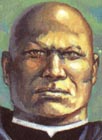
|
l'Ombre Jaune
If there is ONE FU-MANCHU "clone" that ought to be mentioned on
your site, it is "Monsieur Ming, l'Ombre Jaune" (The Yellow Shadow) a recurring
villain in the French adventure series BOB MORANE (both novels & comics). BOB
MORANE is quite an industry, and the "YELLOW SHADOW" a major villain.
There is even an animated series in progress, that will feature the YELLOW SHADOW.
There are quite a few sites (usually in French) devoted to BOB MORANE. The
best two are:
http://www.dbs-eng.uunethost.be/morane/
http://gallery.uunet.lu/Dom/bmorane/moranein.htm
|
|
Reported by Jean-Marc Lofficier,
author of the 1000+ page guide to French
Science Fiction, Fantasy, Horror & Pulp Fiction.
Jean-Marc has kindly given his permission to share his "Bob Morane" entry.
|
|
Wu Ming Shi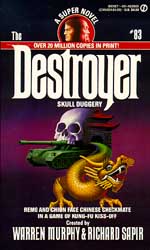
In 1971 Warren B. Murphy and Richard Ben Sapir created a character named
Remo Williams, The Destroyer, and his Korean mentor Chiun, the Master of Sinanju. In the
succeeding 28 years Remo and Chiun have appeared in well over a hundred novels, as well as
comic-book adaptations and an entertaining movie, Remo Williams: The Adventure Begins
(1985), with Fred Ward and Joel Grey.
By the midway point of the series, the production of the Destroyer books had
been turned over to ghost-writers, of whom by far the most prolific was Will Murray. Murray's first
Destroyer novel was #56, Encounter Group, published in 1984. Since then
he has written entries #63 and #69-107 in the series. Murray has also written Doc Savage
novels under the byline Kenneth Robeson and books in the Executioner and Mars Attacks
franchises. He has also written extensively on pulp magazines (especially Doc Savage and
The Shadow), comic books, and other areas of popular fiction, and has reported on the
production of numerous movies for Starlog magazine.
In The Destroyer #83: Skull Duggery (NY: Signet Books #AE6905,
January 1991), Murray paid a somewhat irreverent tribute to a certain sinister character.
Early in the book (page 28) the following conversation takes place between Remo Williams
and Chiun regarding one of Chiun's previous employers:
"A Chinese. An individual. A mandarin."
"Would I know of him?"
"Not under his true name. But he was known to the west under a
silly name, Fu Achoo, or some such nonsense."
Remo made a face. "Fu ... you can't mean Fu Manchu?"
"See? Even you understand what a ridiculous name it is. It was
that lunatic British scribbler's fault. He disseminated all manner of lies and slanders
about me."
"You? What are you talking about? I read those books as a kid. I
don't remember any Koreans in them."
"Precisely, Remo. He changed everything willy-nilly. Where the
Master of Sinanju was at work, he improvised Dacoits. I think that was in The Ears of Fu
Achoo. Dacoits are always cutting their own fingers off by accident. Poisonous spiders,
venomous scorpions, and other insects abound in those ridiculous books. But not one single
Korean. I ended up on the cutting room floor."
"You're mixing your media, but I get what you say."
"It was that so-called author who was mixed up. Imagine a Chinese
named Fu Manchu. The Manchus were not even Chinese. They are nomads, like the
Mongols."
"Little father, I think you are pulling my leg. Fu Manchu was a
fictitious character. He never existed."
Later in the book Remo has an all too close encounter with the principal villain, who
turns out to be the aged mandarin of whom Chiun had told him:
The tall Chinese spoke.
"I am known as Wu Ming Shi. In Mandarin, this means Nameless One,
for no one knows my true name. This is as I wish."
|
|
Jutan
Heavy Hitters: Offcastes. Mike Vosburg: Artist/Writer. New York: EPIC COMICS.
#1 July 1993
#2 August 1993
#3 September 1993
In the 1970s, Mike Vosburg provided many original drawings
for The Rohmer Review.
A quick perusal of the silhouette on the cover offers an immediate hint of this evil
oriental genius' familial ties. The lovely Kaoru is holding one of her pet Zayat Kisses,
"a wasp-like insect, native to southern Nu Dao . . . Its sting is excruciatingly
painful . . . and 100% fatal."
Kaoru dances in a chorus line known as the Zayat Line and wears a costume modeled after
the insect. Cults, plots, assassins and more.
I'm partial, but this is an outstanding example of graphic story-telling. |
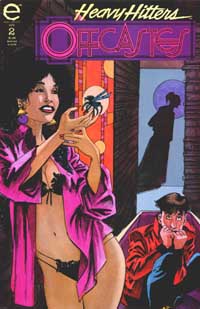
Copyright © 1993 Mike Vosburg. All rights reserved.
Mike Vosburg's web site |
An Old Adversary
"Lin Carter wrote several stories about an occult detective named Anton Zarnak.
In the story 'Perchance to Dream' (which is collected in 'The Xothic Legend Cycle')
Zarnak counters a visitor's rudeness with the following remark:
To quote an old adversary rather imprecisely, I have a doctorate in medicing from
Edinburgh University, a doctorate in theology from Heidelburg, a doctorate in psychology
from Vienna, and a doctorate in metaphysics from Miskatonic; my guests usually address me
as Doctor Zarnak."
-- Matthew Baugh
The Xothic Legend: The Complete Mythos Fiction of Lin Carter.
Chaosium, 1997. 1st, paperback, 271pp.
|
|
The League of Extraordinary Gentlemen.TM
Story: Alan Moore and Artwork: Kevin O'Neill. Wildstorm Publications. A six part series
dated: #1 March 1999, #2 April 1999, #3 June 1999, and #4 November 1999. Issues 5 and 6
have yet to be released. Issue #1 was released with both a "First Printing"
cover and a "Dynamic Forces Exclusive Alternate Cover" limited to 5000 copies.
Alan Moore pits a group of Victorian figures against a Chinese Warlord in London. The
"League" consists of Allan Quartermain (of King Solomon's Mines fame),
Dr.Henry Jekyll (of Dr. Jekyll and Mr. Hyde), Captain Nemo (of Twenty
Thousand Leagues Under the Sea), John Griffin (of The Invisible Man) and
Mina Harker (the lone survivor of Dracula). Many other fictional and real
characters appear and part of the fun is recognizing them.
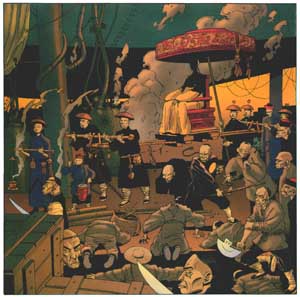
First glimpse of "The Doctor" in #4
Copyright © Alan Moore and Kevin O'Neill
"The man I speak of is a warlord from the Orient, but recently arrived in England.
Little is known of him. It's rumoured he grew up during the Opium Wars in China, and
therefore abhors the British with a vengeance. We know that with brutal efficiency, he has
established himself as absolute crime king of London's East End. Known only as 'The
Doctor,' he's regarded as Satan himself by such few as have survived encountering
him." |
Hark
Planetary. TM Warren Ellis & John
Cassaday. Wildstorm Publications. A continuing series. #1 April 1999.
Introduced in PLANETARY #1 as an integral part of the "secret history" of
the Wildstorm comic-book universe, Hark is an unusual Fu Manchu clone. A
"tall, frightening figure" impeccably dressed in black Western-style suits but
with foot-long lacquered nails, Hark was "the very pinnacle of the ingenuity of the
East." From the turn of the century, he terrorized the Occident -- first
attacking Great Britain and then turning on America -- and eventually found himself in
conflict with Dr. Axel Brass, an analogue of Doc Savage. Doc Brass convinced Hark
that they shared a common goal -- a better world for their people -- and that East and
West could work together. Hark gave up his terrorist activities and joined Brass'
secret society of heroes (all of whom owe their roots to the heroes of the pulps):
his Lordship, a Tarzan pastiche based out of Madagascar; Jimmy, a Secret Operator for
American intelligence, inspired by the Avenger and the Spirit; the Aviator, based on G-8;
Edison, a blatantly "Edisonade" super-inventor; and "the dark millionaire,
the man in black whose guns shouted out against crime in all its forms."
Together they battled such strange foes as the Daemonite aliens, the Murder Colonels, the
Black Crow King, and the dread Charnel Ship.
Hark's name appears to be inspired by Hong Kong action movie director Tsui Hark.
--Sean Tait Bircher |
Dr. Fu Ch'ing
Operation Luna. Poul Anderson. New York: Tor, 1999. The heroes
encounter the Chinese master criminal Dr. Fu Ch'ing, who has a base in
Limehouse and is of undetermined age.
"A tall, thin, stoop-shouldered man stood awaiting us. He had
donned slippers, an embroidered robe, and a mandarin cap topped by a large
spherical button. His hands were delicate, his fingernails very long,
trimmed to points and polished. His head was bald or shaven. Despite his
golden-hued skin and wispy white beard, the features beneath a brow like
Shakespeare's, agelessly smooth, seemed almost too sharp to be Chinese. I
know eyes don't really pierce, but damn if I didn't feel his." (pp.
164-5, hardcover edition).
--Steven Kaye |
Hang Man Chang
"Frenzy of Tongs" was broadcast 19 November 2001
with the villain Hang Man Chang with his
evil daughter Woo Woo.There is a
desk Sgt. called Sgt. Rohmer. Details are found
on the Television page.
|
Phoo Man Choo Choo
An interesting take-off of Fu Manchu in the
Mickey Mouse story "Knit One, Pearl Two" by Pat
and Carol McGreal and Paco Rodriguez.Walt Disney's
Comics & Stories #655 (April 2005). A trip to far Eastern Bhummah
finds Mickey and Minnie crossing paths with a pair of gigantic pearls, a
warlord named Phoo Man Choo Choo, and an pirate queen named
Lotus Blossom.
--Randy Cox |
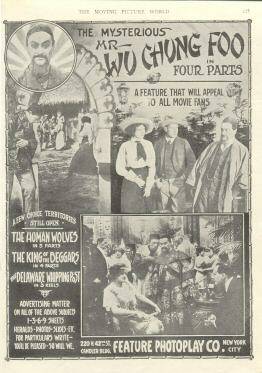
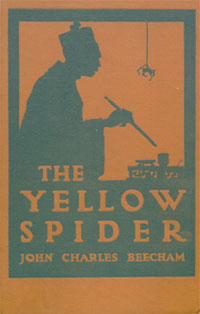 In
The Yellow Spider (Grossep and Dunlap, 1920), John Charles
Beecham's villain is Ah Sing, the Yellow Spider, who is "cruel,
cunning, ruthless, feared the length of the archipelago, the incarnation of
all the savagery and mysticism of the Orient." "His eyes were like
a leopard's in the dark, two dots of green fire that scintillated but did
not blink."
In
The Yellow Spider (Grossep and Dunlap, 1920), John Charles
Beecham's villain is Ah Sing, the Yellow Spider, who is "cruel,
cunning, ruthless, feared the length of the archipelago, the incarnation of
all the savagery and mysticism of the Orient." "His eyes were like
a leopard's in the dark, two dots of green fire that scintillated but did
not blink."
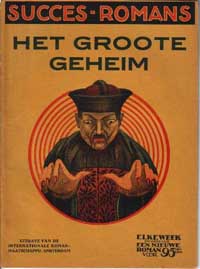
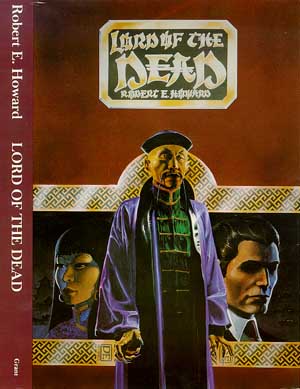

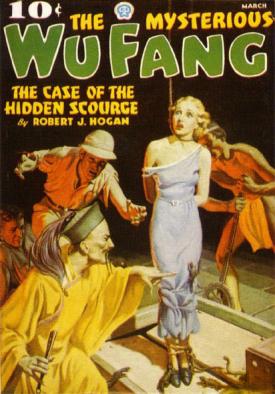
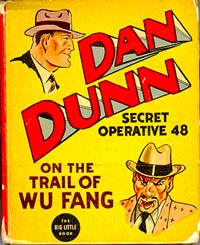

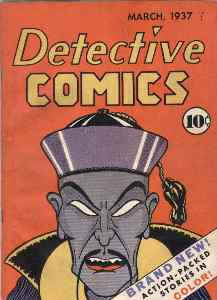
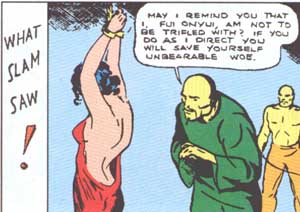
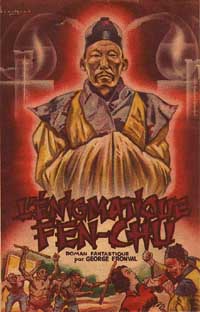
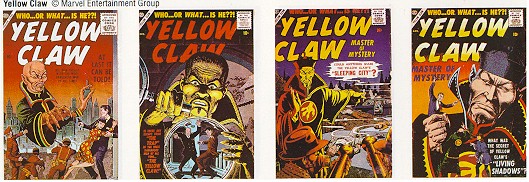


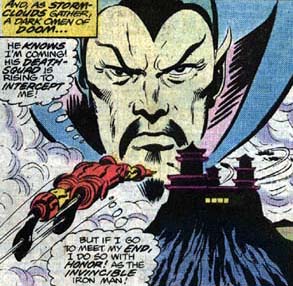
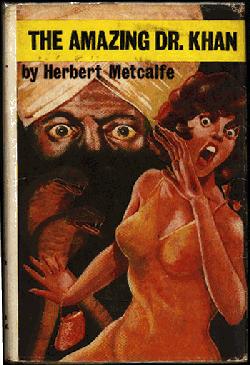
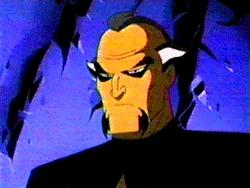
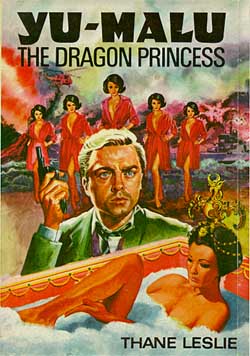
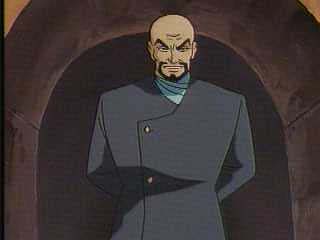
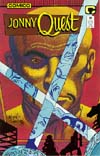 May 1988
May 1988
 Frank Thomas.
Frank Thomas. Weng-Chiang
Weng-Chiang





